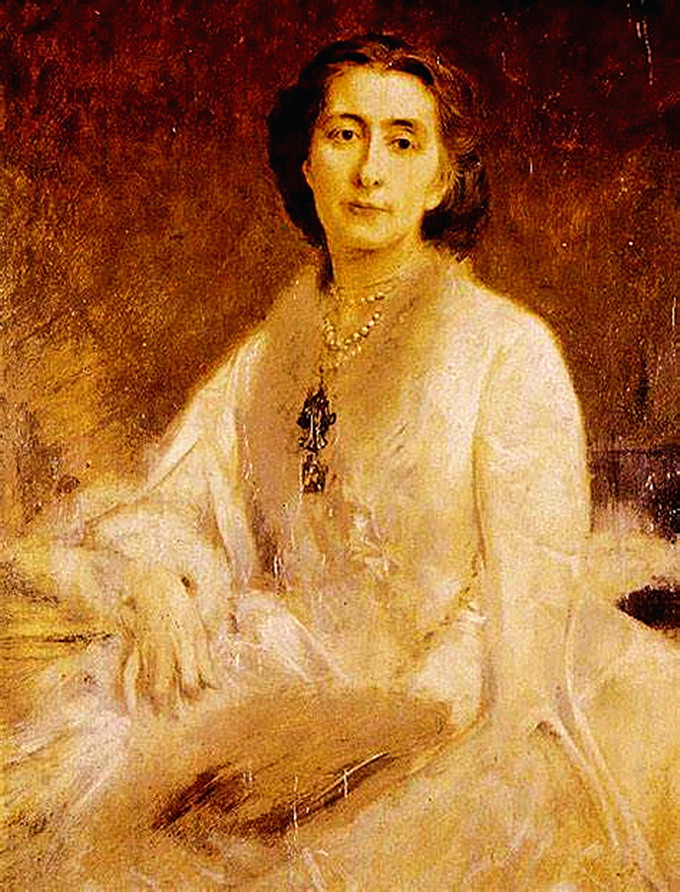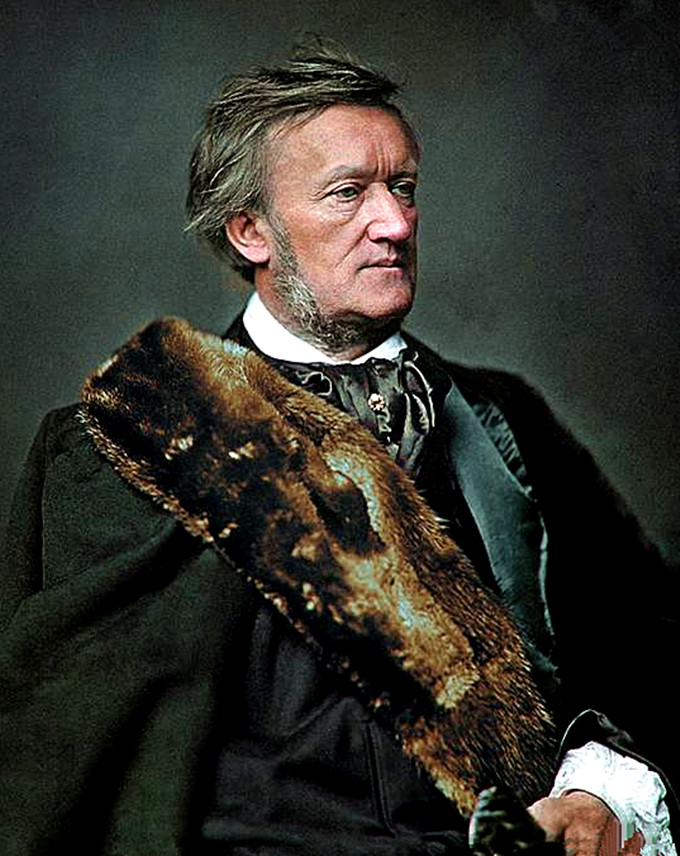|
||||||||||||||||||||||||||
.png) |
 |
|||||||||||||||||||||||||
|
|

|
||||||||||||||||||
|
|
|
|||||||||||||||||
| 理查德·瓦格纳( Richard Wagner,1813-1883) | ||||||||||||||||||
【瓦格纳】特里斯坦与伊索尔德前奏曲和爱之死 (索尔蒂指挥) |
||||||||||||||||||
|
Johann Sebastian Bach
(1685-1750) Goldberg-Variationen, BWV 988 Goldberg Variations • Variations Goldberg Variazioni Goldberg • Variaciones Goldberg Glenn Gould, piano Bruno Monsaingeon Produced at Columbia 30th Street Studio, New York City, April-May 1981 约翰·塞巴斯蒂安·巴赫 哥德堡变奏曲,BWV 988 格伦·古尔德,钢琴 1981年4月至5月,在纽约市哥伦比亚第 30 街工作室制作 © 1981 (2012) 《哥德堡变奏曲》,原名叫做《有各种变奏的咏叹调》,1742 年出版,此作为巴赫的学生哥德堡(Johan Theophil Goldberg)而作。哥德堡是侍奉当时驻在德累斯顿的俄国使臣凯瑟林(Hermann Karl Von Keyserlingk)伯爵的年轻演奏家。巴赫曾把他的《b小调弥撒》献给凯瑟林,因此而获得“宫廷音乐家”的封号。1741-1742 年间,凯瑟林居住在莱比锡,让哥德堡师从巴赫,学习演奏技巧。伯爵患不眠症,失眠时就需哥德堡为其演奏,哥德堡以演奏需要,求巴赫帮助谱曲。巴赫当时作成这部变奏曲之后,凯瑟林送他一只装满 100 枚金路易的金杯以酬谢。 Aria -0:01 Variatio 1 a 1 Clav -2:53 Variatio 2 a 1 Clav -4:03 Variatio 3 a 1 Clav. Canone all'Unisono -4:53 Variatio 4 a 1 Clav -6:23 Variatio 5 a 1 ô vero 2 Clav -7:13 Variatio 6 a 1 Clav. Canone alla Seconda -7:50 Variatio 7 a 1 ô vero 2 Clav. al tempo di Giga -8:30 Variatio 8 a 2 Clav -9:48 Variatio 9 a 1 Clav. Canone alla Terza -10:42 Variatio 10 a 1 Clav. Fughetta -11:42 Variatio 11 a 2 Clav -12:44 Variatio 12 Canone alla Quarta -13:37 Variatio 13 a 2 Clav -15:12 Variatio 14 a 2 Clav -17:54 Variatio 15 a 1 Clav. Canone alla Quinta in moto contrario, Andante -18:54 Variatio 16 a 1 Clav. Ouverture -24:01 Variatio 17 a 2 Clav -25:38 Variatio 18 a 1 Clav. Canone alla Sesta -26:33 Variatio 19 a 1 Clav -27:36 Variatio 20 a 2 Clav -28:38 Variatio 21 Canone alla Settima -29:30 Variatio 22 a 1 Clav. Alla breve -31:42 Variatio 23 a 2 Clav -32:45 Variatio 24 a 1 Clav. Canone all'Ottava -33:43 Variatio 25 a 2 Clav. adagio -35:25 Variatio 26 a 2 Clav -41:26 Variatio 27 a 2 Clav. Canone alla Nona -42:19 Variatio 28 a 2 Clav -43:40 Variatio 29 a 1 ô vero 2 Clav -44:43 Variatio 30 a 1 Clav. Quodlibet -45:44 Aria da capo -47:16 |
||||||||||||||||||
|
|
||||||||||||||||||
|
音乐历史上的今天 1923年10月7日,在慕尼黑发动啤酒馆暴动的前33天,阿道夫·希特勒作为瓦格纳家族的贵宾拜访了拜罗伊特,“他看上去非常普通,穿着巴伐利亚式的皮马裤、羊毛短袜、红蓝相间的格子衬衫,蓝色短夹克裹着他干瘦如柴的身躯。“(弗里德琳德·瓦格纳)。
拜罗伊特音乐节是每年在德国拜罗伊特举行的一场音乐盛会,届时会上演 19 世纪德国作曲家理查德·瓦格纳(1813 -
1883
年)的歌剧作品。瓦格纳本人曾构思并推动设立这样一个特别的音乐节,以展示他自己的作品,尤其是其宏大的《尼伯龙根的指环》和《帕西法尔》系列作品。 |
|
|||||||||||||||||
 |
||||||||||||||||||
| 理查德·瓦格纳( Richard Wagner,1813-1883) | ||||||||||||||||||
| 《特里斯坦与伊索尔德》 | ||||||||||||||||||
|
瓦格纳是19世纪浪漫主义晚期一位极具影响力的作曲家,他将戏剧因素与歌剧因素充分地结合到了一起,力求开创一个新的艺术时代。他强调音乐、戏剧、舞台场面三者并重成为统一整体,同时自己编写剧本,并改变乐队在歌剧伴奏中的从属地位。他的音乐充满了激情,无论是他的“整体艺术”、“主导动机”还是他的“无终旋律”或“半音和声”都预示了西方音乐后来的发展。
瓦格纳一生创作有《仙女》《黎恩济》《漂泊的荷兰人》《尼伯龙根的指环》《特里斯坦与伊索尔德》《罗恩格林》《帕西法尔》《汤豪瑟》《纽伦堡的名歌手》《女武神》等多部乐剧和歌剧。而《特里斯坦与伊索尔德》是瓦格纳的重要歌剧之一,也是他很珍爱的一部作品。歌剧讲述了王妃伊索尔德与将军特里斯坦因误服爱情毒药而相爱,并最终难逃死亡的悲剧。创作期间,瓦格纳承受着政治、感情、生活带来的巨大压力与痛苦,与玛蒂尔黛的感情纠纷也让他多次感到绝望,所以这部作品是瓦格纳当时心理状况的映射,而瓦格纳也在这部作品中寻求着精神解脱。 前奏曲以剧中一些主导动机为材料串联而成,概括了全剧的基调。大体上音乐从象征爱情的主导动机开始,一上来就是特里斯坦和弦,半音上升的渴望、半音下行的悲叹,以及两个线条结合起来的和弦,和声本身就是半音上行和半音下行结合起来的,极端地表达了不断渴望、不断欲求的中心意念。逐渐发展到高亢而激动的高潮,而后出现“痛苦”的主导动机,经过矛盾和冲突后,逐渐恢复平静,象征主要人物特里斯坦与伊索尔德从爱情的产生,加上酒药激发性欲,到爱得如火如荼,再经过与命运痛苦的抗争,最后获得了“死的解脱”。乐曲开始时出现的第一个和弦“特里斯坦和弦”是瓦格纳确立的一个特殊结构的和弦,是特里斯坦主导动机(也是爱情主导动机)的一部分,也是瓦格纳在和声方面突破传统,更自由更大胆的一个标志。 这首前奏曲是一个奇迹,从头到尾贯穿了主导和弦、主导动机中引申出的旋律线的各类穿插。它是a小调,但是从头到尾没有出现过主和弦,不断转到另一个调的属七和弦,不断地解决,然后再不断引发更大的紧张。整首前奏曲以极端洗练的笔法和丰富的音乐语言,使主导意念弥漫在整个织体中。就音乐本身而言,它从最轻开始,不断一浪高过一浪,达到高潮,本身线条和结构的把握,也和戏剧完全贴合。另外,它预示了这部戏将出现的重要主导动机,包括渴望的主题、眉目传情的动机、到最后的欣喜若狂。前奏曲堪称这部戏最精妙、最概括的杰作。 《爱之死》是第三幕的终场音乐,是伊索尔德在特里斯坦逝去时,也是在自己弥留之际的一段绝唱,它与前奏曲前后呼应,并在内容与思想上构成了一个有机的整体,反映了瓦格纳在伦理、欲望、爱情、死亡等主题上的深刻洞见。 “尘世、权力、声望、显赫、荣誉、骑士气概、友谊,一切都像一场幻梦烟消云散,只剩下渴望、渴望、无法满足的渴望,它不断涌起,憔悴、饥渴。死亡意味着消失、毁灭、永不觉醒,死是他们的唯一超脱。”“……特里斯坦与伊索尔德的坟墓上长出了长青藤和萝蔓,它们盘绕交错,难解难分地拥抱着。” 一般歌剧在人物即将死去之时以表现悲伤为主,但《爱之死》绝非如此。它所表现的是特里斯坦与伊索尔德在灵魂与精神上的一种超脱,达到一种新的境界,更类似于佛教文化中的“进入极乐”与基督教文化中的“升入天堂”。这时的伊索尔德是一种沉浸在爱与超脱中的幸福状态,并爆发着内在的精神力量,甚至这种境界超脱了爱的范围,是一种无穷的难以言表的喜悦,“幸福地让人流淌出眼泪”。 |
||||||||||||||||||
 |
||||||||||||||||||
| 理查德·瓦格纳的孙女、齐格弗里德·瓦格纳的女儿, 本文开篇的作者弗里德琳德·瓦格纳 | ||||||||||||||||||
| Richard Wagner's granddaughter, the daughter of Siegfried Wagner. The author of this article, Friedlind Wagner. | ||||||||||||||||||
 |
||||||||||||||||||
 |
||||||||||||||||||
| 阿道夫·希特勒与维尼弗雷德·瓦格纳,巴伐利亚州拜罗伊特,1939 年(黑白照片) | ||||||||||||||||||
| Adolf Hitler with Winifred Wagner, Bayreuth, 1939 (b/w photo) | ||||||||||||||||||
| 理查德·瓦格纳的孙女、齐格弗里德·瓦格纳的女儿 本文开篇的作者弗里德琳德·瓦格纳 | ||||||||||||||||||
| Glenn Gould's performance on the piano was unique.He always sat on his father's very low chair, singing while playing. | ||||||||||||||||||
 |
||||||||||||||||||
| 弗里德琳德·瓦格纳的妈妈 和希特勒 | ||||||||||||||||||
 |
||||||||||||||||||
| 希特勒像(Adolf Hitler,1889 -1947年),生于拜仁和奥地利的边界城市,卒于柏林。是纳粹党的最高领袖和德意志第三帝国的元首。 | ||||||||||||||||||
| The statue of Adolf Hitler (1889 -1947), born in Bayern and a border city of Austria, died in Berlin. He was the supreme leader of the Nazi Party and the head of state of the Third German Empire. | ||||||||||||||||||
 |
||||||||||||||||||
| 这便是希特勒终生所崇拜的德国大作曲家瓦格纳(1813-1883年)。“凡是想了解国家社会主义(即纳粹一赵注)的德国人必须了解瓦格纳。”——希特勒常常这样说。那么,纳粹运动究竟同瓦格纳音乐有什么关系呢?他的音乐果真是纳粹运动的先驱吗? | ||||||||||||||||||
| This was the German composer Wagner (1813-1883), whom Hitler had always revered throughout his life. "Anyone who wants to understand National Socialism (that is, the Nazi regime) in Germany must understand Wagner." - Hitler often said this. So, what is the connection between the Nazi movement and Wagner's music? Was his music really the precursor of the Nazi movement? | ||||||||||||||||||
| 希特勒与拜罗伊特音乐节的关系 | ||||||||||||||||||
|
第一次世界大战期间,音乐节停办,而战后的经济萧条,则使瓦格纳家族濒临破产, 在第三帝国期间,由于希特勒本人是一个狂热的瓦格纳迷,同时也是瓦格纳家族的朋友,因此拜罗伊特音乐节,受到了当时官方的大力支持。但是第二次世界大战结束以后,由于瓦格纳家族和纳粹政权的亲密关系,音乐节则险些被永久性的取消。 希特勒年轻时代,就不会错过任何一场瓦格纳歌剧,和很多人一样,瓦格纳的音乐令希特勒如痴如醉,历史学家布里吉特·哈曼(Historian Brigitte Hamann)撰写的文献集《希特勒与拜罗伊特》记录了“元首”与拜罗伊特音乐节千丝万缕的关系。 |
||||||||||||||||||
 |
||||||||||||||||||
| 德国历史上11月9日“啤酒馆暴动” | ||||||||||||||||||
|
在德国历史上,11月9日是个特殊的日子。 1923年11月9日,希特勒率领纳粹党徒,在慕尼黑的贝格勃劳凯勒啤酒馆发动政变,妄图夺取国家政权,史称“啤酒馆政变”。不过这场闹剧很快便以失败告终,希特勒锒铛入狱,纳粹党及其武装组织冲锋队被判为非法组织,被迫解散。 然而,奇怪的是,啤酒馆政变的失败不仅没有断送掉希特勒的政治前途,还在客观上推动了纳粹运动的发展,被希特勒称为“一段传奇”。狱中服刑的9个月里,希特勒在狱中撰写了《我的奋斗》一书,被视为法西斯的理论和行动纲领。政变虽然失败了,希特勒却在这场政变中名声大噪,得到了越来越多暴力分子的追捧和膜拜。 1933年11月9日,希特勒在每年的11月9号都到慕尼黑贝克勃劳凯勒啤酒馆发表演说,纪念“啤酒馆政变”。 1938年11月9日又发生了“水晶之夜”事件。希特勒在出席庆祝啤酒馆政变15周年活动中,授意青年团、盖世太保和党卫军袭击德国和奥地利的犹太人,这是纳粹对犹太人有组织的屠杀的开始。当晚,许多犹太人的窗户被打破,破碎的玻璃躺了满街满巷,在月光的照射下,晶莹剔透,犹如水晶。有人做过统计,仅这一夜被砸毁的玻璃,损失就达600万马克,相当于比利时全国半年生产玻璃的总价值。德国人因此讥讽这个夜晚为“水晶之夜”。 1939年11月9日,英雄乔治·艾尔塞在啤酒馆台上柱子里面埋下炸药,打算把来这里参加纪念活动讲演的希特勒炸死未遂。 |
|
|||||||||||||||||
 |
||||||||||||||||||
| 少年时代的格伦·古尔德 | ||||||||||||||||||
| Glenn Gould in his youth | ||||||||||||||||||
| 古尔德出生于 1932 年,是独生子。他识谱的能力远超识字能力,早在能够阅读文字之前就已经学会了识谱。他的父母将毕生精力都投入到这个意外的晚生身上,并且他的母亲亲自教导他。他三岁或四岁时就已经开始演奏了。古尔德演奏了所有人们能想到的作曲家的作品:李斯特、肖邦、舒曼、门德尔松,当然还有巴赫。在他辉煌的时期(他称之为“辉煌时期”),也就是 12 岁或 13 岁的时候,古尔德甚至演奏了所有肖邦和李斯特的作品系列。当古尔德 14 岁时,他在多伦多皇家音乐学院管弦乐团的指挥维克多·费尔德布里尔的带领下,演奏了贝多芬的第四协奏曲。他说:“走出来的是这个身材瘦长的孩子,他有着神童的名声。”“我们从未见过有人以这样的姿势坐在钢琴前。但他的演奏和音乐才华是显而易见的。他的演奏为贝多芬带来了全新的光彩。” | ||||||||||||||||||
 |
||||||||||||||||||
| Born in 1932,Gould an only child, he learned to read music before he could read words. His parents dedicated their lives to this surprise late birth and his mother taught him. He was already playing at the age of 3 or 4. Gould played all the music of composers one would expect: Liszt, Chopin, Schumann, Mendelssohn, and of course Bach. During his days of glory, as he called it, at the age of 12 or 13, Gould even played all Chopin and Liszt programs. When Gould was 14 years old, he performed Beethoven Concerto No. 4 with the Royal Conservatory Orchestra in Toronto led by conductor Victor Feldbrill. “Out came this gangly kid with the reputation of a child prodigy.” He said, “We’d never seen anyone sit at the piano in that position. But his playing and musicianship were unmistakable. He shined a new light on the Beethoven.” | ||||||||||||||||||
 |
||||||||||||||||||
| 人生短暂,别错过最美的音乐——其中就包括格伦·古尔德的巴赫 | ||||||||||||||||||
| Life is short. Don't miss out on the most beautiful music - and among them is Glenn Gould's performance of Bach. | ||||||||||||||||||
|
科西玛原名弗兰切斯卡・加埃塔纳・科西玛・李斯特,婚后随夫姓为科西玛・瓦格纳。1862年夏,指挥家彪罗携妻科西玛拜访瓦格纳。彪罗是瓦格纳作品《特里斯坦与伊索尔德》的乐队指挥,也是其忠实追随者与崇拜者,然而瓦格纳与科西玛却秘密相恋,彪罗知晓后痛苦万分,但为前途和心中偶像无奈接受。1865年,科西玛与瓦格纳之女伊索尔德出生,同年这段恋情曝光,天主教会谴责这种混乱关系,在舆论压力下瓦格纳离开慕尼黑。1866
年,瓦格纳妻子米娜去世,科西玛随即携子投奔瓦格纳。1870年,科西玛与彪罗离婚,同年8月,她与瓦格纳成婚,不久儿子齐格弗里德诞生,瓦格纳为纪念此事创作管弦乐作品《齐格弗里德牧歌》。1883年2月13日,瓦格纳因病离世,科西玛悲痛欲绝,甚至试图绝食自尽,经劝说后振作,全身心投入拜罗伊特音乐节建设,保护瓦格纳遗产,于1932年去世,享年92岁。 科西玛·瓦格纳(Cosima Wagner, nee Cosima Liszt,又名Cosima von Bulow1857 - 68),是匈牙利钢琴家、作曲家弗朗茨·李斯特和玛丽·达古特的私生女。她成为了德国作曲家理查德·瓦格纳的第二任妻子,并和他一起创办了拜罗伊特音乐节,以展示他的舞台作品;在他死后,她把她的余生献给了他的音乐和哲学。评论家已经认识到Cosima是瓦格纳后期作品的主要灵感来源,尤其是《帕西法尔》。 科西玛·瓦格纳生于1837年12月25日,伦巴第,Bellagio,伦巴第,奥地利帝国[现在在意大利],1930年4月1日,德国拜罗伊特,作曲家理查德·瓦格纳的妻子,1883 - 1908年拜罗伊特音乐节总监。
|
||||||||||||||||||
| Entering the maze without getting lost, the piano genius Gould | ||||||||||||||||||
| Bach (1635-1750) was a German composer of the Baroque era. His most significant achievement was his contribution to polyphonic music. If Mozart and his music were an inexplicable miracle, then Bach was a certainty. The self-discipline, rigor, and reverence for reason of the German nation, as well as the resilient and profound personality of Bach, made him a master of polyphonic music. There was a certain inevitability to this. Bach's works often centered around a solemn theme, with two or more voices growing and intertwining around this fixed center, rotating upward to form a complex three-dimensional pattern. It was like weaving a complex texture with multiple melodic lines, with the theme in this three-dimensional texture "flying" from one voice to another to form counterpoint, jumping to a peak through a complex "flying" route, all within Bach's steady and confident control. He could place all the details of the music in the exact position, and in his works, there were never any redundant or excessive irrational elements. If we call the content of Bach's music "treasures" and the means of expressing this content - the three-dimensional texture - "traps", then the content is a "treasure" placed in the "traps". Many musicians, in their pursuit of these "treasures", wandered in the "traps" throughout their lives. The musical process of Bach was like a complex reproduction process, with the theme appearing several times, ten times or more in the texture, and less skilled performers could only be in a state of chaos in the "traps" (sometimes even very excited, thinking they were approaching the "treasure"); for the audience, this performance was a repetitive, boring, and tedious experience. Fortunately, there emerged the genius Glenn Gould (1932 - 1982). The communication between Gould and Bach, which took place on the staff paper over a period of 300 years, was a blessing for both of them, for humanity, and for music. A good performer should possess the following conditions: 1. Love for music; 2. The ability to express the perfect techniques of music; 3. High wisdom - being able to see through the staff paper and have the ability to capture the soul hidden behind the staff. Many performers have the first and second conditions, but there are too few with high wisdom! Canadian pianist Glenn Gould is one of the few performers who simultaneously possess these three conditions. His third condition is more different from ordinary people. Gould's contribution to Bach's music is like Schnabel's contribution to Beethoven's piano works, Furtwängler's contribution to Beethoven's symphonic works, and Corto's contribution to Chopin's works. The difference is that the interpretations of the latter three masters almost defined a composer's work and became the authoritative interpretation in our minds, while Gould was never the spokesperson for any work. Gould's special fondness for Bach's works was not because of Bach himself (perhaps the composer's name was just a symbol for him to distinguish different works), but he used the possibilities provided by Bach's staff paper to realize his own musical ideals. In Bach's works, his talent was fully demonstrated. Gould's purpose of entering the "traps" was not for the "treasure", but he only focused on deciphering the process of the "traps". If he had a "magic cube" in his childhood, he might have been a "cube enthusiast"; if he were a painter, his obsession with structure and composition might have been far greater than his love for color language. Gould was a very individualistic pianist. His understanding and handling of the works were very unique. Listening to his performance should be done from an appreciation perspective, not from a teaching or imitation perspective. It was unwise of him. His genius understanding of the music and his highly individualistic touch keys made it difficult to be imitated. A pianist should express his own personality, of course, based on a proper understanding of the piece. Listening to Gould's performances is truly thrilling. He has every reason to be so confident. Only when one has an unparalleled passion for music can one play with such dedication, and he plays with his entire life, with music being his very breath. Gould's playing of Bach is an extremely special phenomenon in the history of Bach's performances. Bach is over 300 years away from us, and Gould's interpretation of Bach is completely new, a leap. He enables us to re-recognize Bach. His playing is fresh, unique, and natural. He uses different touch keys and playing techniques to vividly and interestingly present each voice of Bach. Of course, merely listening to Gould's performances of Bach's works cannot be considered as having a comprehensive understanding of Gould. His performances of Beethoven, whether in concertos or variations, are all very wonderful. He is full of talent and is a rare genius. I can't sense anything strange about him. | ||||||||||||||||||
 |
||||||||||||||||||
|
||||||||||||||||||
| 古尔德在 31 岁时便从音乐舞台上退役,他的最后一场演出于 1964 年 4 月 19 日举行。他认为通过录制作品,他的听众群体能够扩大,并且在他看来这是一个进步的举措。古尔德还想从事其他工作,比如制作演出、剧本以及有关人类状况的广播纪录片。 | ||||||||||||||||||
| Gould retired from the concert stage at the age of 31, his final concert on April 19, 1964. He felt his audience could be larger through recording and that in his mind it was a step forward. Gould wanted to do other things such as producing shows, and scripts, and radio documentaries that were commentaries on the human condition. | ||||||||||||||||||
 |
||||||||||||||||||
|
||||||||||||||||||
| 格伦·古尔德为什么被称为“巴赫在20世纪的最佳代言人” | ||||||||||||||||||
|
古尔德为什么能够成为巴赫在20世纪的最佳代言人?这决定于他独特的音乐观。 除了巴赫,古尔德的演奏范围相当广:从文艺复兴的吉本斯到20世纪的勋伯格。但纵观上下,这些作品都有一个特点:对位。 "对位是使不同旋律在不同声部中和谐进行的艺术。" 这是音乐辞书的解释。广义的说来,公元10世纪当作曲家们在圣咏的旋律上方或下方的四度或五度加上一个平行运动的旋律时,就有了最初的对位法。到了文艺复兴时代,对位法得到了高度的发展,而巴洛克音乐,特别是巴赫的音乐则是欧洲音乐史上对位发展的最高峰:赋格、大协奏曲这样的体裁把两条、三条、更多的旋律交织在一起。古典主义兴起的年代,对位法遭到了冷落;而海顿、莫扎特和贝多芬三位大师又让对位在主音音乐和调性对比的基础上向前发展了一大步。到了20世纪,新古典主义的崛起,更提高了对位的地位。作曲家们采用对位构成多调性的音色对比而不是旋律对比。为古尔德所钟爱的作曲家和作品,总的来说都注重对位的运用。莫扎特晚期的作品不像早期那样注意对位,古尔德便这样语出惊人:“莫扎特不是死的太早,而是太晚!”。 对位意味著对比,意味著冲突,意味著矛盾,意味著斗争。而古尔德本人何尝又不是生活在冲突、矛盾、斗争之中!是他,在一个曰益功利化、物质化的社会中,依然放弃了前途无量的舞台生涯;是他,蔑视保守的音乐观,一次次让评论家们瞠目结舌。这是古尔德与社会的抗争,这是古尔德与自我的抗争——最终,都转化为他左手与右手的抗争。 一般的演奏家面对对位稠密的巴赫音乐,明智些的都或多或少的简化它们。古尔德是个左撇子。也许这使他能够更加清晰的把巴赫的低音线条倾吐出来,也使得他能够以与常人不同的角度去理解巴赫的音乐。他敢于也有能力向这座关著吃人米诺牛的迷宫发起冲击。 古尔德为什么能够成为巴赫在20世纪的最佳代言人?也许他们在气质上有许多相似的神韵。 "一个人可以在丰富自己时代的同时并不属于这个时代;他可以向所有时代述说, 因为他不属于任何特定的时代这,是一种对个体主义的最终辩护。他声明,一个人可以创造自己的时间组合,拒绝接受时间规范所强加的任何限制。"古尔德这样评价作曲家理查德·施特劳斯,也许说这是古尔德对自己的评价更恰当些。"他与时代的每一种可能的潮流都背道而驰。" 古尔德这样评价巴赫。这也像是他的自嘲。 巴赫的晚年生活在心灵的孤独中。儿子称他为"老古董",市民们沉醉于歌剧院里充满卖弄的咏叹调,雇主则用斥责回答他的天才……他无意于开创一个新的世界——他自知这不是他力所能及,这不是上帝给他的使命。他把一切余热用去修补那个即将随他逝去的旧世界,让它与自己一起完美的死去。古尔德的一生也生活在孤独中。无论在舞台上他能得到多少鲜花和掌声,无论他的唱片能买多少万张,他都厌倦,都孤独。因为世界上没有几个人能够完全理解他的哲学,就像世纪初的物理界无法理解爱因斯坦和他的相对论。总之他不属于这个时代。他自称是"最后一个清教徒"——声明自己属于过去。总之他不属于这个时代,他是个没有光环的先知——他属于未来。 |
||||||||||||||||||
 |
||||||||||||||||||
| 格伦·古尔德和他的爱犬尼克在一起 | ||||||||||||||||||
| Glenn Gould with his dog, Nick | ||||||||||||||||||
 |
||||||||||||||||||
| 路德维希二世.《路德维希二世》是一幅高质量的手绘油画复制品。 | ||||||||||||||||||
|
Ludwig II. Das Gemälde "Ludwig II." als hochwertige, handgemalte Ölgemälde-Replikation. |
||||||||||||||||||
| 童话国王——路德维希二世,理查德瓦格纳的音乐剧很早就给了这位国王音乐灵感。路德维希希望在即位后,尽快将这位作曲家请到慕尼黑,实现举办音乐节的想法。在1864年他召见了瓦格纳,从而也将瓦格纳从他最大的困境中解救了出来。 | ||||||||||||||||||
| The Fairy Tale King - Ludwig II. Richard Wagner's operas had already provided the king with musical inspiration long ago. Ludwig II hoped to invite the composer to Munich as soon as he ascended the throne, in order to realize the idea of holding a music festival. In 1864, he summoned Wagner, thus rescuing Wagner from his greatest predicament. | ||||||||||||||||||
| 这便是希特勒终生所崇拜的德国大作曲家瓦格纳(1813-1883 年)。“凡是想了解国家社会主义(即纳粹一赵注)的德国人必须了解瓦格纳。”-一希特勒常常这样说。那么,纳粹运动究竞同瓦格纳音乐有什么关系呢?他的音乐果真是纳粹运动的先驱 | ||||||||||||||||||
 |
||||||||||||||||||
| 爸爸亲手制作的椅子一直在录音棚里陪伴着古尔德 | ||||||||||||||||||
| The chair made by Dad himself has been accompanying Gould in the recording studio all along. | ||||||||||||||||||
 |
||||||||||||||||||
| 古尔德左手指挥右手(摄于60年代后期) | ||||||||||||||||||
| Gould was conducting with his left hand while using his right hand for other tasks (photo taken in the late 1960s) | ||||||||||||||||||
 |
||||||||||||||||||
| 格伦·古尔德为《哥德堡变奏曲》精心标注的乐谱完整变化 | ||||||||||||||||||
| Glenn Gould's meticulously annotated score of the "Goldberg Variations" has been completely revised. | ||||||||||||||||||
 |
||||||||||||||||||
| 格伦·古尔德手迹 | ||||||||||||||||||
| Glenn Gould's Autograph | ||||||||||||||||||
 |
||||||||||||||||||
| 格伦·古尔德戴着手套的样子 | ||||||||||||||||||
| Glenn Gould with his gloves | ||||||||||||||||||
 |
||||||||||||||||||
| 古尔德在电视节目中扮演一个虚构的人物——英国指挥“泰斗”尼格尔·特维特-桑维特爵士 | ||||||||||||||||||
| Gould played a fictional character on a TV show - Sir Nigel Twitt-Sandwick, the "giant" of British conductors. | ||||||||||||||||||
 |
||||||||||||||||||
| 1964年1月,古尔德在多伦多大学授予荣誉学位的典礼上发表了演讲 | ||||||||||||||||||
| In January 1964, Gould delivered a speech at the ceremony where honorary degrees were awarded by the University of Toronto. | ||||||||||||||||||
 |
||||||||||||||||||
| 古尔德与伯恩斯坦、斯特拉文斯基在哥伦比亚唱片公司(1960年) | ||||||||||||||||||
| Gould, Bernstein and Stravinsky were on the Columbia Records label (in 1960) | ||||||||||||||||||
 |
||||||||||||||||||
| 格伦·古尔德和科妮莉亚·福斯 | ||||||||||||||||||
| Glenn Gould's Autograph | ||||||||||||||||||
| 格伦·古尔德 1968 年 1 月 6 日的音乐会最后终止 。 | ||||||||||||||||||
| 不久之后,他与指挥家、作曲家兼钢琴家卢卡斯·福斯的妻子科妮莉亚·福斯的长时间通话促成了这段恋情。科妮莉亚原本打算与古尔德结婚。古尔德对她忠心耿耿,关爱有加,性格温和亲切。1968 年的照片显示这对夫妇衣着时髦。他和孩子们喜欢和古尔德的柯利犬玩耍,还会一起外出旅行,但随着时间的推移,古尔德变得越来越多疑。他服用抗抑郁和抗焦虑药物,随意混合服用,而且他日益严重的疑病症和古怪行为愈发严重。当科妮莉亚离开他时,古尔德悲痛欲绝。她和她的孩子们从 1968 年到 1972 年一直与他生活在一起。他再也不会有如此亲密的关系了。 | ||||||||||||||||||
| Glenn Gould’s 1/6 1968 Concert Dropout. | ||||||||||||||||||
| Shortly thereafter, his long phone conversations with Cornelia Foss, the wife of conductor, composer, and pianist Lucas Foss, resulted in an amorous liaison. Cornelia had every intention of marrying Gould. Devoted to her and to her children, Gould was warm and sweet, and caring. Photos from 1968 show a chic couple. He and the children loved romping with Gould’s collie and going on road trips, but as the years passed Gould became increasingly paranoid. He took medications for depression and anxiety, mixing them indiscriminately and his increasing hypochondria and eccentricities intensified. Glenn was devastated when Cornelia left him. She and her children had lived with him from 1968-1972. He would never again have such a close relationship. | ||||||||||||||||||
 |
||||||||||||||||||
| 格伦·古尔德的施坦威牌 CD 318型钢琴,还有古尔德爸爸亲手制作的椅子,放置在他位于多伦多的公寓里。 | ||||||||||||||||||
| Glenn Gould's Steinway CD 318 piano, along with the chair that Gould's father made himself, is placed in his apartment in Toronto. | ||||||||||||||||||
 |
||||||||||||||||||
| 格伦·古尔德 巴赫 《巴赫全集》 | ||||||||||||||||||
| Glenn Gould the Complete Bach Collection | ||||||||||||||||||
 |
||||||||||||||||||
| 格伦·古尔德档案馆《1981 年未发行的录音室现场完整版》 | ||||||||||||||||||
| THE GLENN GOULD ARCHIVES "The Unreleased Complete Live Recording Sessions from 1981" | ||||||||||||||||||
 |
||||||||||||||||||
| 多伦多皇家音乐学院以格伦·古尔德命名的音乐学院 | ||||||||||||||||||
| The Royal Conservatory of Music in Toronto, named after Glenn Gould | ||||||||||||||||||
|
|
||||||||||||||||||
|
Today in the
history of music On October 4, 1982, Glenn Gould passed away due to a cerebral hemorrhage at the age of 50 years and 9 days. In the Evergreen Cemetery in Toronto, a granite tombstone in the shape of a piano was engraved with: Glenn Gould. Glenn Gould (Glenn Gould, September 25, 1932 - October 4, 1982) was a Canadian pianist. He was born in Toronto, Ontario, and graduated from the Royal Conservatory of Music in Toronto. He was renowned for his performances of Bach's works. Gould set his goal to become a pianist at the age of 5, mastered Bach's "Harmonic Suite" Volume 1 at the age of 10, became the youngest graduate of the Royal Conservatory of Music in Toronto at the age of 12, and made his first public performance with the Toronto Symphony Orchestra at the age of 15. In 1955, he became famous in the United States by performing "The Goldberg Variations", and then signed a contract with Columbia Records and recorded this piece. In 1964, he stopped public performances and turned to the recording studio, completing the recordings of all of Bach's piano concertos and the "Harmonic Suite". In 1981, he re-recorded "The Goldberg Variations", and this album became the starting point and endpoint of his career. On October 4, 1982, he passed away due to a cerebral hemorrhage at the age of 50. Today's video: 1. Glenn Gould's "Bach: Goldberg Variations"; 2. Glenn Gould's Legend: Life After Life (in English). |
||||||||||||||||||
|
|
||||||||||||||||||
 |
||||||||||||||||||
| 格伦古尔德原版封面作品集 | ||||||||||||||||||
| Glenn Gould Original Cover Art Collection | ||||||||||||||||||
 |
||||||||||||||||||
| 格伦·古尔德的墓碑,上面刻有《哥德堡变奏曲》的音符 | ||||||||||||||||||
| Glenn Gould’s tombstone, with the Goldberg Variations | ||||||||||||||||||
|
|
||||||||||||||||||
| 理查德·瓦格纳《齐格弗里德牧歌》 | ||||||||||||||||||
| Gould's Legend: Life After Life and Before | ||||||||||||||||||
|
古尔德的时光之旅 顾尔德的时光之旅(台) 古尔德传奇:来世今生 古尔德: 时光之旅 Glenn Gould: Hereafter Glenn Gould: Au delà du temps 古尔德传奇:来世今生(英文) |
||||||||||||||||||
|
Gould's Journey Through Time Gould's Journey Through Time (TV) Gould's Legend: Life After Life and Before Gould: Journey Through Time Glenn Gould: Hereafter Glenn Gould: Beyond Time |
||||||||||||||||||
| 未得原作者编者授权严禁转载www.mt77.com任何内容 | ||||||||||||||||||
|
|
|
|||||
|
copyright © 2003-2005 xilu.com all rights reserved. |
|||||
|
|
|||||













